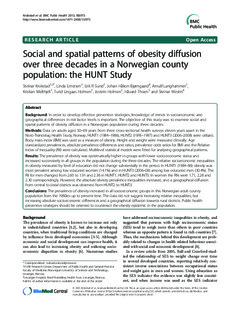| dc.description.abstract | Background: In order to develop effective preventive strategies, knowledge of trends in socioeconomic and geographical differences in risk factor levels is important. The objective of this study was to examine social and spatial patterns of obesity diffusion in a Norwegian population during three decades.
Methods: Data on adults aged 30–69 years from three cross-sectional health surveys eleven years apart in the Nord-Trøndelag Health Study, Norway, HUNT1 (1984–1986), HUNT2 (1995–1997) and HUNT3 (2006–2008) were utilized. Body mass index (BMI) was used as a measure of obesity. Height and weight were measured clinically. Age standardized prevalences, absolute prevalence differences and ratios, prevalence odds ratios for BMI and the Relative Index of Inequality (RII) were calculated. Multilevel statistical models were fitted for analysing geographical patterns.
Results: The prevalence of obesity was systematically higher in groups with lower socio-economic status and increased successively in all groups in the population during the three decades. The relative socioeconomic inequalities in obesity measured by level of education did not change substantially in the period. In HUNT1 (1984–86) obesity was
most prevalent among low educated women (14.1%) and in HUNT3 (2006–08) among low educated men (30.4%). The RII for men changed from 2.60 to 1.91 and 2.36 in HUNT1, HUNT2 and HUNT3. In women the RIIs were 1.71, 2.28 and 2.30 correspondingly. However, the absolute obesity prevalence inequalities increased, and a geographical diffusion from central to distal districts was observed from HUNT2 to HUNT3.
Conclusions: The prevalence of obesity increased in all socioeconomic groups in this Norwegian adult county population from the 1980ies up to present time. The data did not suggest increasing relative inequalities, but increasing absolute socioeconomic differences and a geographical diffusion towards rural districts. Public health preventive strategies should be oriented to counteract the obesity epidemic in the population. | nb_NO |
